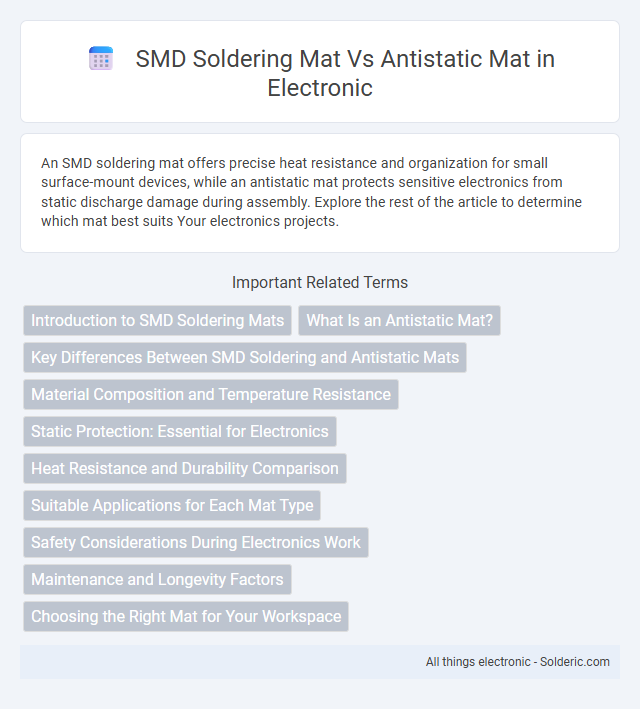An SMD soldering mat offers precise heat resistance and organization for small surface-mount devices, while an antistatic mat protects sensitive electronics from static discharge damage during assembly. Explore the rest of the article to determine which mat best suits Your electronics projects.
Comparison Table
| Feature | SMD Soldering Mat | Antistatic Mat |
|---|---|---|
| Primary Purpose | Provides heat resistance and a workspace for Surface-Mount Device soldering | Prevents electrostatic discharge (ESD) damage to sensitive electronic components |
| Material | Heat-resistant silicone or rubber | Conductive or dissipative rubber/plastic with grounding capability |
| Heat Resistance | High heat resistance (up to 500degC or more) | Generally low to moderate heat resistance |
| Electrostatic Protection | Minimal or none | Effective ESD protection with grounding options |
| Common Usage | Workspace for precise soldering of small electronic components | Protects electronic components during assembly, testing, and repair |
| Design Features | Organizational patterns, component holders, heat-resistant zones | ESD grounding points, dissipative surface textures |
| Price Range | Moderate to high depending on features | Low to moderate |
Introduction to SMD Soldering Mats
SMD soldering mats provide a heat-resistant surface designed specifically for precise soldering of Surface Mount Devices, ensuring protection for delicate components during assembly. These mats often feature silicone construction that withstands high temperatures up to 500degC, preventing damage to your workbench and components. Unlike generic antistatic mats, SMD soldering mats combine heat resistance with static dissipative properties, making them essential for efficient and safe soldering workflows.
What Is an Antistatic Mat?
An antistatic mat is designed to dissipate static electricity from electronic components, preventing electrostatic discharge (ESD) damage during soldering or assembly. Unlike typical SMD soldering mats, which primarily provide heat resistance and a non-slip surface, antistatic mats contain conductive or dissipative materials that safely channel static charges away from sensitive devices. These mats are essential in electronics manufacturing environments to protect integrated circuits and other delicate components from costly static-related failures.
Key Differences Between SMD Soldering and Antistatic Mats
SMD soldering mats are designed to withstand high temperatures and provide a non-slip surface for precise electronic component soldering, with heat-resistant silicone materials that prevent damage during soldering processes. Antistatic mats, on the other hand, focus on dissipating electrostatic discharge (ESD) to protect sensitive electronic components from static damage, often featuring conductive layers and grounding points. Key differences include their primary function--thermal resistance for SMD mats versus ESD protection for antistatic mats--and material properties tailored to these specific requirements.
Material Composition and Temperature Resistance
SMD soldering mats are typically made from heat-resistant silicone rubber, allowing them to withstand temperatures up to 500degC, making them ideal for precise soldering tasks. Antistatic mats often combine conductive rubber or PVC with static-dissipative materials to prevent electrostatic discharge, but their temperature resistance usually peaks around 120degC to 150degC. The higher thermal tolerance of SMD soldering mats ensures durability during solder reflow processes, while antistatic mats prioritize static control over heat resistance.
Static Protection: Essential for Electronics
SMD soldering mats provide a heat-resistant surface but lack inherent static protection, making them less suitable for handling sensitive electronic components. Antistatic mats are engineered with conductive materials that safely dissipate electrostatic discharge (ESD), protecting delicate electronics during soldering and assembly. Using an antistatic mat is crucial for maintaining device integrity and preventing ESD damage in precision electronic work.
Heat Resistance and Durability Comparison
SMD soldering mats typically offer higher heat resistance, withstanding temperatures up to 500degC, making them ideal for prolonged soldering tasks without deformation. Antistatic mats prioritize electrostatic discharge protection but often have lower heat tolerance, usually around 150degC to 200degC, which can limit their durability under intense soldering conditions. Choosing the right mat depends on your need for heat endurance versus static protection in your workspace.
Suitable Applications for Each Mat Type
SMD soldering mats are specifically designed for precision work involving small surface-mount devices, providing excellent heat resistance and a non-slip surface ideal for delicate electronics assembly. Antistatic mats, by contrast, are primarily used in environments where electrostatic discharge (ESD) protection is crucial, making them essential for handling sensitive electronic components across manufacturing and repair settings. Selecting between these mats depends on whether the task prioritizes thermal stability and component positioning or ESD protection to safeguard circuit integrity.
Safety Considerations During Electronics Work
SMD soldering mats are designed to withstand high temperatures and protect your workspace from accidental burns and solder splashes, enhancing safety during electronics assembly. Antistatic mats, on the other hand, primarily prevent electrostatic discharge (ESD) that can damage sensitive electronic components, ensuring your devices remain safe from static-related failures. Choosing the right mat depends on whether thermal protection or ESD safety is your priority in maintaining a secure work environment.
Maintenance and Longevity Factors
SMD soldering mats are typically made from silicone, offering heat resistance and easy cleaning, which enhances their longevity with minimal maintenance. Antistatic mats, designed to prevent static electricity buildup, require regular grounding checks and gentle cleaning to maintain their ESD protection properties. Choosing the right mat depends on your workspace needs, as proper care of your SMD soldering or antistatic mat can significantly extend its functional lifespan.
Choosing the Right Mat for Your Workspace
Choosing the right mat for your workspace depends on your specific needs: an SMD soldering mat offers excellent heat resistance and protects against solder splashes, making it ideal for precision soldering tasks, while an antistatic mat is designed to dissipate electrostatic discharge and safeguard sensitive electronic components. Your choice should consider the type of electronic work you perform most frequently--whether you require thermal protection or electrostatic safety. Ensuring the mat matches your workflow reduces damage risks and enhances soldering efficiency.
SMD soldering mat vs antistatic mat Infographic

 solderic.com
solderic.com